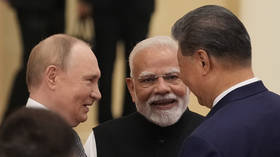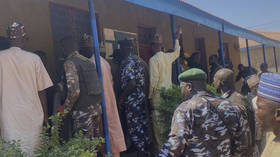US-Russia Reset vs. European Missile Shield

The American missile defense system in Europe is aimed at creating global tension. Political scientist Igor Panarin believes that part of the British-American transnational elite is trying to destabilize Europe and start a new Cold War.
In the article below, Panarin explains his view. Due to the missile defense system, Russia and the US find themselves in a situation which some experts call the end of the “reset” and the beginning of a new Cold War. Essentially, we’re looking at the US’s intentional attempt to question Russia’s status as a great nuclear state, and start dismantling the foundation of Russia’s state security system. Will the Russian-US reset continue in 2012? It probably will, if it withstands the missile defense test. So far, there have been strong doubts about it, which have grown even stronger since the pre-term deployment of the radar in Stelogorsk. On 28 December Russian President Medvedev introduced his Voronezh-DM radar. The radar is capable of detecting up to 500 ballistic and cruise missiles launched from land as well as ocean within up to six thousand kilometers. Similar radar, Voronezh-M has already been deployed in Lekhtusi, outside St. Petersburg, and another Voronezh-DM radar, in the Armavir district, Krasnodar Region. The United States made their statement in response to deploying the radar in the Kaliningrad Region. This radar became a symbol of Russia’s readiness to respond to deployment of the anti-Russian missile defense system in Europe. The US representatives said that an option of agreeing with Russia was still out there. But they have doubts about it. The trick is that soon, the “architect” of the reset between Moscow and Washington, Michael McFaul, will soon become the US ambassador to Russia. His candidacy has been approved by the Senate Committee on Foreign Relations. At the hearing regarding his statement, even McFaul said that the US Presidential Administration would deploy the US missile defense system regardless to whether it improves its cooperation with Russia in this matter or not. Thus it will be quite difficult to reach an accord between Russia and America. The Russian President has recently listed a number of potential response measures. Among them was the deployment of Iskander missile complexes in the Kaliningrad Region. Iskanders can carry conventional or nuclear warheads. Russia could also reinforce its “asymmetric response” with a number of efficient foreign policy tools. For instance, Moscow should revisit its current collaboration with the United States on a number of significant issues, such as the transit of supplies for the US military effort in Afghanistan. Notably, Russia can gain additional leverage on Washington now that the United States is about to fall out completely with its long-standing strategic partner Pakistan over the recent “friendly fire” incident. Following a misguided NATO air strike that killed 24 Pakistani servicemen, thousands of enraged locals took to the streets in Karachi and several other cities across Pakistan to protest US military presence. One of the protests featured a burning effigy of President Barack Obama, as well as US flags similarly set on fire. Pakistan’s top brass have slammed President Asif Ali Zardari and Prime Minister Yousaf Raza Gillani for what is seen as their excessive reliance on America. This has prompted Islamabad to react swiftly and furiously to the air strike, entirely shutting down the transit corridor for the coalition forces stationed in Afghanistan, and issuing a statement demanding that the US troops should clear the Shamsi air base in the province of Balochistan within 15 days. This demand poses a serious impediment for the US-led coalition in Afghanistan, since the Pakistan transit corridor used to be the shortest and most convenient supply route for the allied troops. This puts Russia in a position to seal the only remaining passage for coalition supplies to Afghanistan – a move that could urge Washington to think twice with regard to its plans for a European missile shield. By taking advantage of the current bottleneck situation, Russia could effectively prevent the United States from deliberately targeting Russia’s nuclear deterrence capabilities, and therefore destabilizing Europe and sparking a new Cold War. A 100,000-strong US force could be trapped in Afghanistan with no food and ammunition supplies, haunted by the plight of the British with Elphinstone’s Army, which was isolated and totally massacred in Afghanistan in 1842. I personally hope that all American GIs presently stationed in Afghanistan will safely make it back home, and that the US will give up on it plans on encircling Russia with its missile defense architecture in Europe, signaling its commitment to further promoting the US-Russia “reset” in 2012.
Prof. Igor Panarin, Doctor of Political Sciences, for RT
The statements, views and opinions expressed in this article are solely those of the author and do not necessarily represent those of RT.












